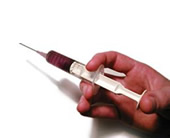-
Bosscher Foundation Live!
The new website is finally live Bosscher Foundation.Read more...
Information
The Active Components In Local AnestheticsAnesthetics are generally administered with the aim of eliminating the pain experienced during treatment. Thanks to anesthesia, the patient can relax during the treatment, thereby allowing the dentist to concentrate on the procedure in hand.
Local anesthetics are seldom, if ever, discussed with the patient. The reason for this rests equally with the dentist as with the patient. For the dentist local, anesthesia is merely a means to an end, i.e. achieving an optimal result with the patient's teeth. The dentist quite often lacks specific knowledge pertaining to the pharmaceutical characteristics of the anesthetic and other active ingredients present in the capsules. A general practitioner, dentist or dental surgeon certainly knows more than enough to administer a local anesthetic, but they are not pharmacists.
Read more...
History of local anesthetics
The first people, as far as we know, with knowledge of local anesthesia were the inhabitants of Peru. They had long known that chewing on coca leaves caused a numbing of the mucous membrane in the mouth.
It was not until the latter half of the 19th century that research into this effect was conducted in Europe. This lead to the first eye operation under local anesthesia by the eye surgeon, Kol Ier in Vienna in 1884. The anesthesia was achieved using cocaine. Following this first successful operation cocaine was increasingly administered as a local anesthetic.
Read more...
The Articaine Problem - Patients
At the beginning of the 90's, Marthe Bosscher came across a relatively large number of patients in her natural-healing practice, who were suffering from health problems, which were for the most part attributed to amalgam fillings. This is easily detected using the Dr Voll method of electro-acupuncture measurement. After diagnosing these symptoms, patients were advised to have their (metal) amalgam fillings replaced with less toxic alternatives and to contact their dentist.
Read more...
The Articaine Problem - Professionals
At the beginning of the 90's, Marthe Bosscher came across a relatively large number of patients in her electro-acupuncture and natural-healing practice, who were suffering from health problems, attributed for the most part to amalgam dental fillings. This was easily detected using the Dr Voll method of electro-acupuncture measurement. After diagnosing these symptoms, patients were advised to have their amalgam fillings replaced with less toxic alternatives and to contact their dentist.
Read more...
Advantages and Disadvantages of Articaine Hydrochloride
Characteristic for articaine HCl is that they are fast acting and effective in penetrating bone. The latter has not been proven scientifically but is the opinion of those who work with these products. When using articaine HCl, the patient no longer has to return to the waiting room to allow the anesthetic to take effect. During treatment, it seems as though articaine HCl are more effective than most other anesthetics. For these reasons, increasing numbers of dentists and dental surgeons are opting for articaine HCl.
Read more...

 NL
NL  EN
EN  DE
DE 
